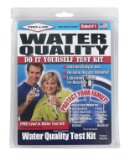Create Your Own Emergency Water Supply
any of us who are otherwise well prepared for weather related emergencies, power outages, or other disasters are put to scratching our heads when we try to figure out a good method of storing water for emergency use. It’s easy to have a couple of five-gallon jugs of water stored away, but the storage of a larger quantity of clean, usable water is a more difficult task. Not all of us have bubbling springs or deep, clear wells on our property. In some instances, without electricity, even those water sources can be inaccessible.
It is commonly known that under extreme emergency circumstances, a person can get by for quite a while without food, but only for a short time without water. Under normal conditions in moderate weather, an adult needs about two to three quarts of water each day. That amount would naturally be increased if the person is engaged in heavy physical labor or any hard physical activity. Therefore, a minimum of about four to five gallons would need to be stored for each person for one week’s needs. The problem then is to come up with a plan to supply the needed water for your family for an extended period of time.
One method which I have come up with is quite simple, inexpensive, and effective. It is made up of materials which are obtainable at no cost or at low cost. It can add an additional 125 to 150 gallons of water to your storage supplies.
The system consists of connecting three used water heater tanks in series to your existing water supply to provide a battery of water storage tanks. The number of tanks is arbitrary. Theoretically, you can plumb in a tank for each member of your household. This method will maintain up to 150 gallons of consistently fresh water as a backup to the quantity already contained in the existing water heater. An added benefit of this method is that, until it is needed in an emergency, it allows incoming water to warm to room temperature before entering the household water heater, thereby reducing the amount of electricity or gas required to heat your normal household water supply.
To obtain the parts and materials necessary for your water storage battery, you’ll need to hit up a local plumber or appliance dealer. They usually have old water heating units waiting to be hauled off and can be easily persuaded to let you have a couple of old water heaters just for hauling them off.
It may require a bit of diligence in searching for the tanks to use in your system. Most water heaters are not discarded unless the tank has developed a leak somewhere. Stay with it, and you should be able to locate the needed tanks.
For purposes of setting up the water storage battery, you’ll first need to remove the outer jacket and insulation from each unit. To do this, start by removing any panels or covers attached with screws. With a hacksaw-type blade in your sabre saw, cut down the length of the metal cabinet near the seam. By carefully removing this metal cabinet, you can end up with some good heavy-gauge sheet metal to be used for a variety of projects around the homestead.

Once the tank has been removed from the water heater jacket, it would be a good idea to clean it out a bit. To do this, you can remove the heater elements and flush out the inside. This should remove most of any buildup of limestone or other deposits which may be inside the tank. If you live in an area of heavy mineral deposits, such as limestone, this may take a bit of effort. Once the tank is flushed out, you may wish to go a step further and wash out the inside with a bleach solution. Rinse well and reinstall the elements, tightening them well to make a tight, leakproof seal. Instead of replacing the elements, you may install threaded plugs in their place. Placement of the tanks will have to be customized to your particular location. Remember that each of the tanks weighs in the neighborhood of 50 pounds and 50 gallons of water weighs an additional 417 pounds or so. This will make the weight of a three-tank battery about 1400 pounds. A good solid floor will be required to support a load of this size. As a base for the units, you can easily place concrete blocks atop each other or on end and place over them a couple of 2x8s. While the raised tanks are not absolutely necessary, they are helpful, if for no other reason than to make withdrawing water from the tanks easier through the drain valves located near the bottom of the tanks. And consider using a metal strap to secure the units to the wall for protection against upsets during an earthquake or other disaster.
Plumbing in the tanks is an easy enough matter. Simply connect the tanks so that the incoming household water supply enters the first tank, leaves it and enters the second tank, exits it and enters the third tank, then reconnects to the existing household supply line. The fittings needed for the required connections are easily obtainable at the local hardware store.
If or when the emergency supply is needed, you must first immediately shut off the main water supply valve to your water line. This would be especially critical in the event that you suspect your main water supply has been contaminated.
Once the water main has been shut off, you can easily draw off needed water from the tank drain valves located near the bottom of each tank. For a good water flow, you may have to open a faucet or two in your household system to allow air to flow into the pipe system.
The beauty of this system is that it is adaptable to nearly any water system and can be sized from a single tank to as many as you need and have room for. It can help you to be better prepared for an unexpected “long dry spell.”
Additional Research:
  |
Leave a Reply